
Let’s talk about the most despised insects in the garden — at least they are the ones that I despise the most. Besides the brown marmorated stink bug which has taken great delight in sticking its mouthparts into every single unripe tomato on my tomato vines, the Japanese beetle is the worst garden insect. What are the Japanese beetles eating in YOUR garden? Here’s a series of photos from my garden showing some damage this year.
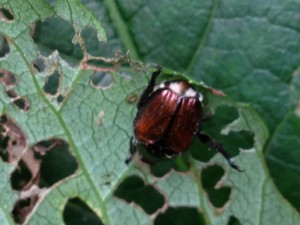
It seems that the Japanese beetles definitely favor certain plants in my garden. In previous years, they would congregate on my impatiens flowers and on my grape vine. This year, I didn’t plant impatiens due to the disease that they’re carrying. The grape vine is still affected by the Japanese beetles this year. And a few plants to add to the list: All of my native Virginia Creeper vines have Japanese beetle damage, as do my climbing hydrangeas, my oakleaf hydrangeas, my Russian Olive shrubs, and the flowers on my Rose of Sharon shrubs. I don’t have many roses blooming this time of year — they flower nicely in Spring and then tend to stop blooming until Fall — so the roses have skipped the Japanese beetle damage.
Normally, I would spray for the Japanese beetles, or collect them in a jar. I’ve had less time this year to personally collect them. One year, I collected two full mustard jars of Japanese beetles. This year, I haven’t collected many due to not having much time during the week. See my “collection” jars below!
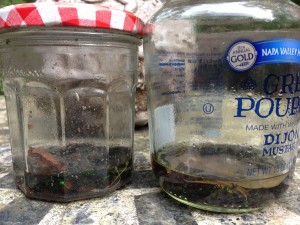
The Japanese beetles tend to love the leaves on my grape vine. The beetles don’t pay attention to the bunches of grapes, yet they do love to pulverize the leaves.
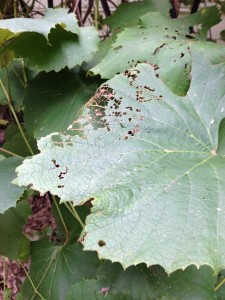
Also, this year the Japanese beetles are devouring my climbing hydrangeas and some leaves on my oakleaf hydrangeas, too. I’m not sure why they love the climbing and oakleaf hydrangeas…but they do. The Japanese beetles don’t touch my other hydrangeas. Odd.
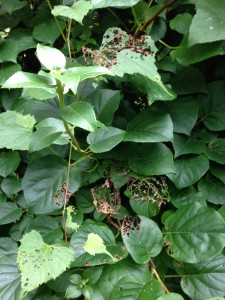
The Japanese beetles are devouring my native Virginia Creeper vines this year, including the one that started to climb up my deck stair railing.

Some gardeners in my area consider the Russian Olive shrub to be invasive. I love the sweetly mesmerizing fragrance of the Russian Olive flowers in the Spring. The Japanese beetles seem to find it to be delicious!

Additionally, the Japanese beetles tend to love my Rose of Sharon flowers. If bothered by the beetles, the flowers will not open, and instead will crumble and fall apart. I hadn’t seen much Japanese beetle damage in the past few years on my Rose of Sharon shrubs — but this year, there’s much more damage to the flowers.
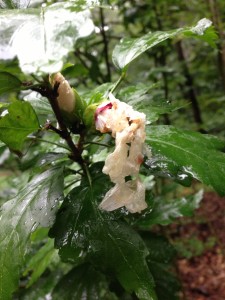
I’ve found that the easiest method of control is to pick the Japanese beetles off the plants and knock them into a bucket of soapy water or a jar filled with rubbing alcohol. Either way, the beetles should be fewer next year. We have tried grub control on our lawn, however, that doesn’t seem to be effective as we are still seeing the beetles. Of course, your neighbors need to do their own Japanese beetle control or the beetles will continue to exist from year-to-year.
I do like to use the Bayer Tree and Shrub Protection on my more prized trees and shrubs. The application comes in both granular and liquid form. Each treatment will usually last a year and will protect the plants from other insects as well.
The plants will recover eventually. I usually remove the damaged leaves after the Japanese beetles have died for the season.
What are the Japanese beetles devouring in your garden? Leave a comment and let me and my other readers know!
++++++++++++++++

Leave a Reply
You must be logged in to post a comment.